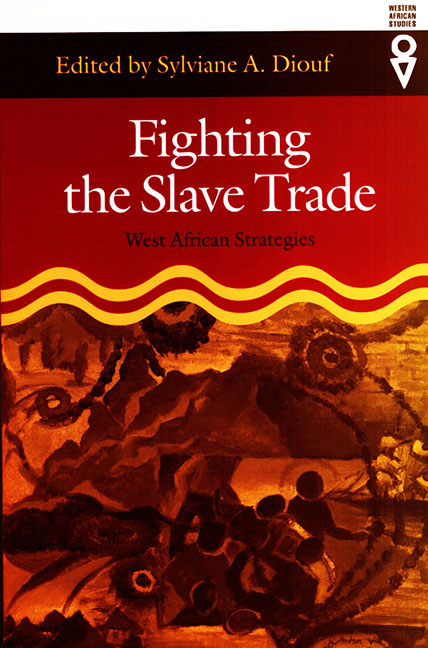Book contents
- Frontmatter
- Contents
- Preface
- Introduction
- PART 1 DEFENSIVE STRATEGIES
- PART 2 PROTECTIVE STRATEGIES
- PART 3 OFFENSIVE STRATEGIES
- 8 Igboland, Slavery, and the Drums of War and Heroism
- 9 “A Devotion to the Idea of Liberty at Any Price”: Rebellion and Antislavery in the Upper Guinea Coast in the Eighteenth and Nineteenth Centuries
- 10 Strategies of the Decentralized: Defending Communities from Slave Raiders in Coastal Guinea-Bissau, 1450–1815
- 11 The Struggle against the Transatlantic Slave Trade: The Role of the State
- 12 Shipboard Revolts, African Authority, and the Transatlantic Slave Trade
- Epilogue: Memory as Resistance: Identity and the Contested History of Slavery in Southeastern Nigeria, an Oral History Project
- Contributors
- Index
11 - The Struggle against the Transatlantic Slave Trade: The Role of the State
from PART 3 - OFFENSIVE STRATEGIES
Published online by Cambridge University Press: 30 August 2017
- Frontmatter
- Contents
- Preface
- Introduction
- PART 1 DEFENSIVE STRATEGIES
- PART 2 PROTECTIVE STRATEGIES
- PART 3 OFFENSIVE STRATEGIES
- 8 Igboland, Slavery, and the Drums of War and Heroism
- 9 “A Devotion to the Idea of Liberty at Any Price”: Rebellion and Antislavery in the Upper Guinea Coast in the Eighteenth and Nineteenth Centuries
- 10 Strategies of the Decentralized: Defending Communities from Slave Raiders in Coastal Guinea-Bissau, 1450–1815
- 11 The Struggle against the Transatlantic Slave Trade: The Role of the State
- 12 Shipboard Revolts, African Authority, and the Transatlantic Slave Trade
- Epilogue: Memory as Resistance: Identity and the Contested History of Slavery in Southeastern Nigeria, an Oral History Project
- Contributors
- Index
Summary
THE FIRST RECORDED SHIPMENT of captives from western Africa over the Atlantic by Europeans occurred in 1441 (Blake 1977, 5). These were victims of raids by the Portuguese in the small coastal communities of Senegambia.Subsequently, persistent Portuguese demand for captives stimulated supply, on the basis of which trade in captives developed and the Portuguese gave up forceful capture, to be resumed later in west-central Africa after the establishment of their colony of Angola in the late sixteenth and early seventeenth centuries (Vansina 1992, 558–59). The Portuguese chronicler Azurara records that by 1448 nearly one thousand captives had been shipped to Portugal from western Africa (Blake 1977, 16–17). The colonization of the Americas by European powers in the early sixteenth century and the concomitant phenomenal growth of demand for slave labor there catapulted the trade to heights that completely dwarfed all trade in humans ever recorded in history, especially during the plantation revolution in the Americas, between 1650 and 1850. From the 1440s to the 1860s, millions of people, variously estimated by recent research at between 12 million and 20 million (Inikori and Engerman 1992; Inikori 1998; H. Klein 1999; Eltis 2000), were shipped against their will by Europeans and European colonists.
Why was demand for slave labor in the Americas exclusively focused on Africa? Why did the export of captives from Europe come to an end just as the demand for slave labor was about to explode? What conditions in Africa sustained the supply of so many export captives for so long a period of time? What did the individuals and communities do to protect themselves from capture and sale for export? What did the governments in Africa do to protect their subjects? What role did the shift of European demand from the predominance of African products to the predominance of captives play in the evolution of state institutions and the direction of foreign policy in the states of Africa? What factors explain state involvement in the export trade in captives?
Despite the impressive research of the past three decades these overlapping questions are not adequately addressed in the literature. They help to define the focus of this chapter, which specifically addresses the role of the state in the struggle of communities and individuals in Africa against the Atlantic slave trade.
- Type
- Chapter
- Information
- Fighting the Slave TradeWest African Strategies, pp. 170 - 198Publisher: Boydell & BrewerPrint publication year: 2004

